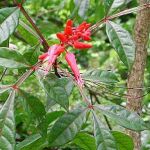| Common Name: |
Surinam Quassia |
| Other Names: |
Bitter Wood |
| Botanical Name: |
Quassia amara |
| Genus: |
Quassia |
| Family: |
Simaroubaceae |
| Native Location: |
C America to Brazil |
| Cultivation: |
Moist, rich, sandy soil in partial shade. Prefers high humidity. |
| Propagation: |
By ripewood cuttings in autumn. |
| Harvest: |
Wood is cut as required and chipped for use in decoctions. |
| Height: |
3m (10ft) |
| Width: |
1.5m (5ft) |
| Hardiness: |
Min. 10°C (50°F) |
| Parts Used: |
Wood |
| Properties: |
An odorless, bitter, tonic herb that lowers fever, stimulates the digestive system, and expels intestinal parasites. |
| Medicinal Uses: |
Internally for poor appetite and digestion, anorexia, alcoholism, feverish illnesses (especially malaria), and roundworms. Externally as an enema for threadworms, as a lotion for skin parasites, and in rinses for dandruff and head lice; also in preparations to stop nail biting. |
| Culinary Uses: |
Extracts are added to beer, spirits, and soft drinks. |
| Economic Uses: |
Quassia chips are used to make an insecticide for insect pests, such as aphids and spider mites, also as a fly killer. |
| Warning: |
Excess causes gastic irritation and vomiting |
| Bibliography: |
Encylopedia of Herbs by Deni Brown Copyright ©: 1995, 2001 Dorling Kindersley Limited pg. 338
|

